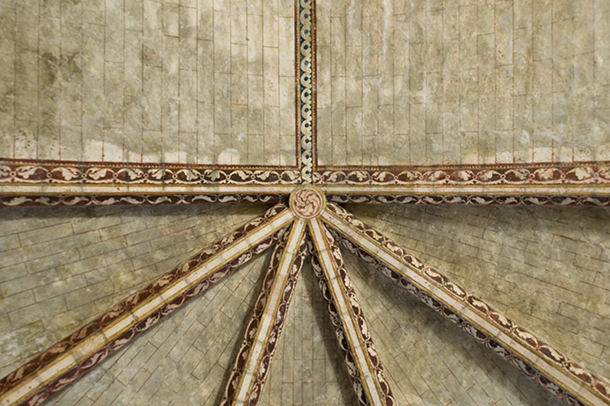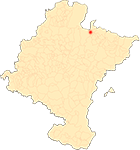Roncesvalles
By Javier Martínez de Aguirre Aldaz
Crypt of the church
The unevenness of the terrain made it necessary to build a crypt under the chancel. Its scarce use over the last few centuries has favoured the conservation in an acceptable state of the mural paintings that decorated it from its origin. We are, therefore, faced with a rare survivor from ancient times in the much modified canonical complex and the only medieval space in Navarre that conserves in its entirety the pictorial mural covering with which it was endowed by those who conceived it.
Its plan roughly repeats the layout of the main chapel, with a semi-decagonal chancel and rectangular section. Six ribs starting from small columns located at the corners of the polygon articulate the vault and converge at core topic.
The most remarkable aspect is the existence of the pictorial covering that covers almost all of the walls and vaults. Six colours predominate: white, yellow, blue, grey and two shades of red. In some motifs there was an attempt to represent volumetry by means of coloured shading, most of which has disappeared.
The surface of the apse was divided into two registers: the wall with imitation drapery (a motif particularly common in painted plinths from the 12th to 14th centuries) formed by network of lozenges containing stars and quatrefoils; and the vault, full of reddish tracery on a light background. The registers are separated by a 30-centimetre border with fretwork. A border with pseudo-palmettes frames the western wall and runs along the axis of the vault. The blind panels of the apse repeat the same layout. The three central ones, where the windows open, only show a cut executed with double vertical strokes.
The pictorial ensemble, in its modesty, is not irrelevant. The motifs used are not repeated in other churches on the Iberian Peninsula, so it can be assumed that they were executed by the team of French artists who built the church. It is also the only collection of early Gothic mural painting in Navarre and offers us the highest quality repertoire of non-figurative medieval painting in Navarre.
Dectot, X., "Yacente de Sancho VII el Fuerte", in Bango Torviso, I.G. (dir. cient.), Sancho el Mayor y sus herederos. El linaje que europeizó los reinos hispanos, Pamplona, 2006, pp. 371-373.
Fernández-Ladreda, C., Imaginería medieval mariana en Navarra, Pamplona, 1989.
Fernández-Ladreda, C. (Dir.), Martínez Álava, C., Martínez de Aguirre, J. and Lacarra Ducay, M.C., El arte gótico en Navarra, Pamplona, 2015.
Fuentes y Ponte, J., report histórica y descriptiva del santuario de Nuestra Señora de Roncesvalles, Lérida, 1880.
García Gainza, M.C., Orbe Sivatte, M. and Domeño Martínez de Morentin, A., Catalog Monumental de Navarra IV**. Merindad de Sangüesa, Pamplona, 1992.
Ibarra, J., History of Roncesvalles. Art. History. Legend, Pamplona, 1936.
Lambert, E. Roncevaux", Bulletin Hispanique, XXXVII (1935), pp. 417-436.
Martínez de Aguirre, J. (coord.), Enciclopedia del Románico en Navarra, Aguilar de Campoo, 2008, vol. III, pp. 1216-1224.
Martínez de Aguirre, J., Gil Cornet, L. and Orbe Sivatte, M., Roncesvalles. Hospital and sanctuary on the Camino de Santiago, Pamplona, 2012.
Miranda García, F. and Ramírez Vaquero, E., Roncesvalles, Pamplona, 1999.
Peris, A., "El Ritmo de Roncesvalles: estudio y edición", Cuadernos de Filología Clásica. Latin Studies, 11 (1996), pp. 171-209.
Pons Sorolla, F., "project de obras de restauración en la capilla del Sancti Spiritus de la Real Colegiata de Roncesvalles (Navarra)", Príncipe de Viana, XXXIX (1978), pp. 59-77.
Soria i Puig, A., The Road to Santiago. II. Stations and signs, Madrid, 1992.
Torres Balbás, L. La iglesia de la hospedería de Roncesvalles", Príncipe de Viana, VI (1945), pp. 371-403.
Thuile, J., L'Orfèvrerie en Languedoc du XIIe au XVIIIe siècle. Généralité de Montpellier, Montpellier, 1966.












